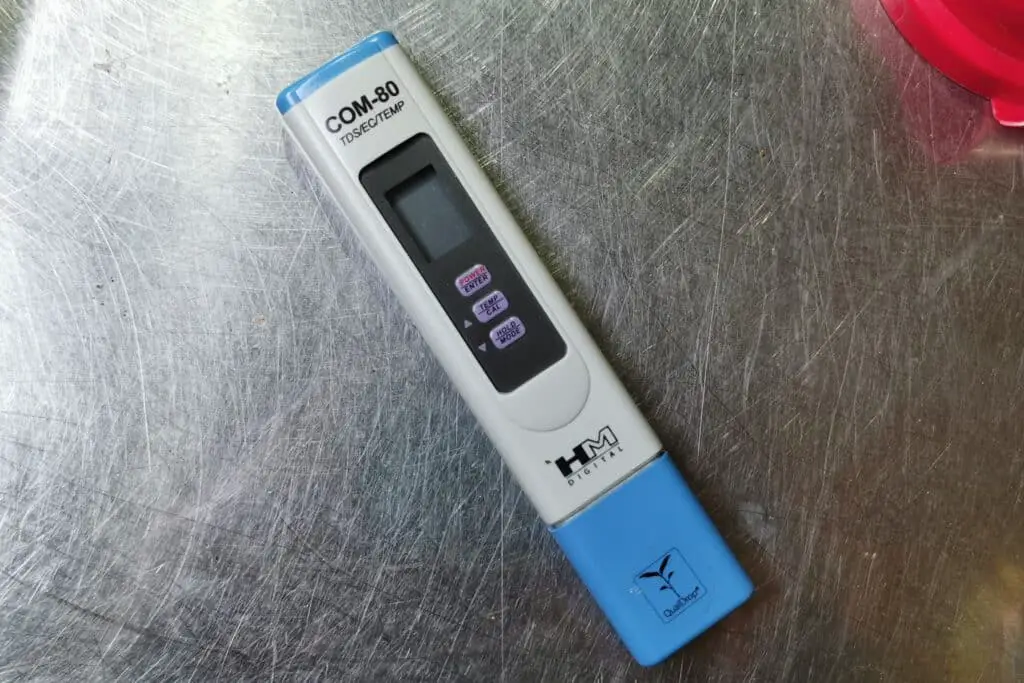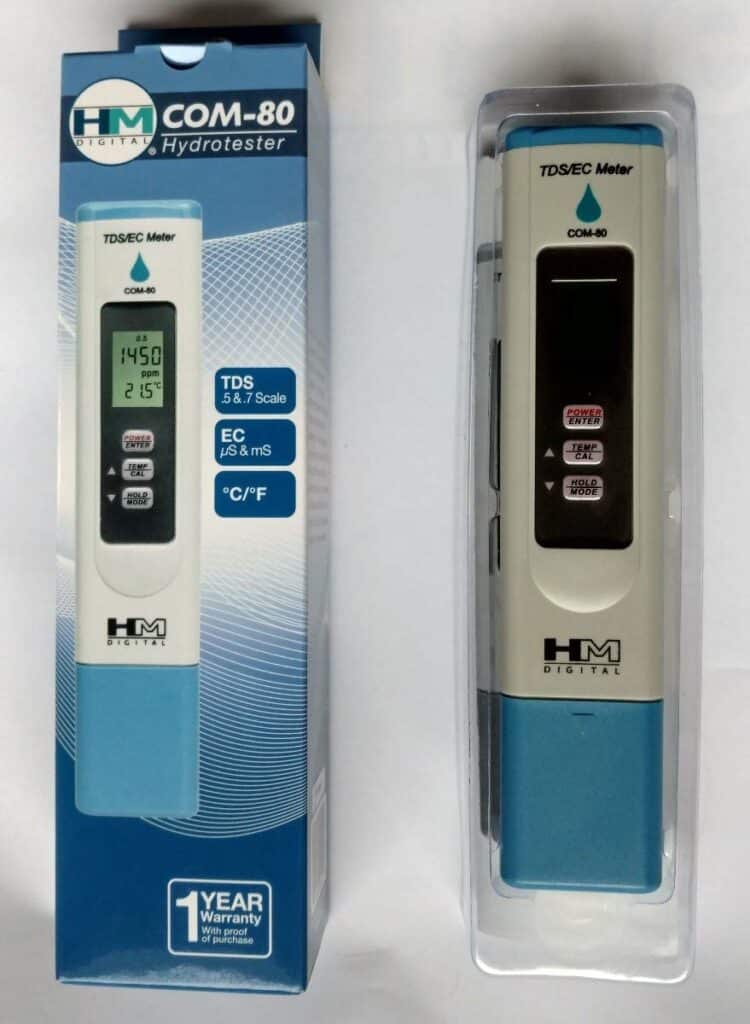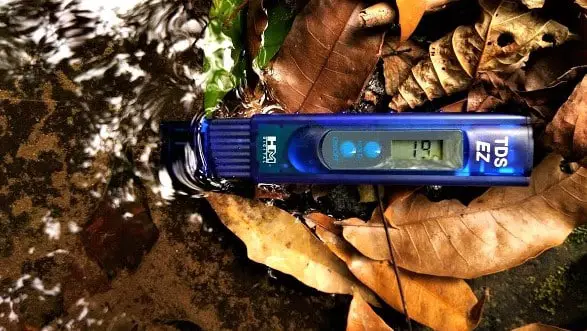TDS and Conductivity Pens
I.Introduction
Welcome to my page on TDS and conductivity pens! This is going to be a product page linking to Amazon, and I will only be listing items that I have personally used.
If you work with water or other liquids, then you know how important it is to measure their total dissolved solids (TDS) and conductivity levels. TDS refers to the amount of dissolved inorganic and organic substances in a liquid, while conductivity measures its ability to conduct an electrical current.
TDS and conductivity pens are compact and easy-to-use devices that allow you to quickly and accurately measure these important parameters.
It’s important to note that TDS pens are primarily used to measure the purity of reverse osmosis water or other forms of pure water. While they can give you an idea of the general level of dissolved solids in a liquid, they cannot tell you the specific makeup of those solids.
For a more comprehensive analysis of water quality, you may want to consider using a water test kit, which we will discuss in another post. However, if you’re looking for a quick and easy way to measure TDS and conductivity levels, a pen can be a convenient tool to have on hand.
On this page, I’ll share the TDS and conductivity pens that I use and recommend, along with their features and benefits. I prefer conductivity over TDS because it is more accurate.
It’s important to note that most TDS pens read conductivity first and then use an equation to convert conductivity to TDS. Depending on where you live, this equation can be different, so keep that in mind when watching YouTube videos or listening to people on Facebook talk about this.
There are two calibration numbers that are commonly used with TDS meters because there are two different methods for calibrating these devices. One method is called the 0.5 calibration, which is based on the conductivity of a standard solution that contains 0.5 grams of salt per liter of water. This method is commonly used in the United States and other countries.
The other method is called the 0.7 calibration, which is based on the conductivity of a standard solution that contains 0.7 grams of salt per liter of water. This method is commonly used in Europe and other parts of the world.
Both of these calibration methods are used to adjust the TDS meter so that it can accurately measure the amount of total dissolved solids in a liquid. However, they use different standard solutions with different salt concentrations, which can result in slightly different calibration numbers.
It’s also very important to mention that these pens need calibration every few months to keep them accurate. If I can find the calibration solutions for each pen, I will list them as well.
So, if you’re ready to take your water testing to the next level, let’s dive in and explore the world of TDS and conductivity pens!
II. Conductivity And TDS Pens You Can Buy
This is my current pen which I use to measure conductivity which I love.

HM Digital COM-80
The HM Digital COM-80 is an economically priced, reliable electrical conductivity (EC) and total dissolved solids (TDS) meter that is commonly used for a variety of testing applications. It has a measurement range of 0-5000 ppm for TDS and 0-9990 µS for EC, with a resolution of 1 ppm and 10 µS, respectively.
The device has an easy-to-read, large backlit display that shows the measurement results in ppm or µS. It also has a hold function that allows you to freeze the reading on the screen for easy recording, as well as an auto-off function that saves battery life by turning the device off after 10 minutes of inactivity.
The COM-80 is small and compact, making it easy to carry and store. It runs on three LR44 batteries that are easy to replace.
One thing to note is that the COM-80 is primarily designed for testing applications such as hydroponics and gardening, pools and spas, aquariums and reef tanks, water ionizers, drinking water, and commercial applications such as boilers and cooling towers and filtration and purification systems. It may not be as accurate or suitable for other specialized applications that require very precise measurements.
Overall, the HM Digital COM-80 is a reliable, easy-to-use, and affordable option for measuring EC and TDS levels in a variety of liquids.
This pen has a built in thermometer that can measure temperature in both Celsius and Fahrenheit. The temperature range is from 0-80 degrees Celsius (or 32-176 degrees Fahrenheit) and is displayed on the large and easy-to-read LCD screen.
It also features a hold button which is very handy when you are reaching high tanks and cant see the meter very well, simply put the meter in the water to the correct level wait a few seconds press hold and look at the readings.

This is a fantastic pen if you want to buy it you can buy it through this link that takes you to Amazon
Here is the calibration fluid for it
HM Digital TDS-EZ

With the push of a button, the TDS-EZ can tell you your overall water purity level, which will be displayed on the screen in ppm (parts per million).
The lower the TDS level, the purer the water, with 0 ppm being pure H2O. The TDS-EZ is great for checking your tap water quality, or knowing when to change a filter.
quality, or knowing when to change a filter.
The TDS-EZ is an excellent tool for drinking water, water filtration and purification, hydroponics (test your nutrients), aquariums, RO/DI systems, pools and spas, and more.
The meter comes Factory Calibrated with a 342 ppm NaCl solution, we recommend frequent recalibration using the HM Digital 342ppm TDS solution to maintain accuracy.
The TDS-EZ meter has a hold function, which saves measurements for convenient reading and recording. The battery life is approximately 1000 hours of usage, and the power source is 2 x 1.5V button cell batteries (included) (LR44 or equivalent).
The meter also has an auto-off function, which shuts off automatically after 10 minutes of non-use to conserve batteries. The display is a large and easy-to-read LCD screen. The measurement range is 0-9990 ppm.
From 0-999 ppm, the resolution is in increments of 1ppm. From 1000 to 9990 ppm, the resolution is in increments of 10ppm, indicated by a blinking ‘x10’ image. The meter has a fun, translucent blue housing that’s very strong and durable.
The TDS-EZ meters are calibrated with a 342 ppm NaCl solution. The meters can be recalibrated with a mini-screwdriver. The package includes a TDS chart sticker on the back of the meter that explains TDS values.
The TDS-EZ meter comes with a convenient built-in thermometer that can measure temperature in both Celsius and Fahrenheit. You can easily read the temperature range from 0-80 degrees Celsius (or 32-176 degrees Fahrenheit) on the meter’s large LCD screen.
Furthermore, this meter has a handy hold button that allows you to freeze the reading, which is particularly useful when you need to measure liquids in hard-to-reach tanks.
Simply immerse the meter in the water to the correct level, wait a few seconds, press hold, and then you can easily read the TDS and temperature readings.
The meter is available in the color purple.
If you would like to buy it you can do so through this Amazon link
Here is the calibration fluid for it
III. Keep your solutions clean
Keeping the calibration solution clean is crucial for maintaining the accuracy of your EC or TDS meter. Any contaminants that come into contact with the solution can throw off the readings, resulting in inaccurate measurements. To prevent this, it is recommended to use distilled water to flush the probe before and after calibrating.
This helps to remove any residual contaminants from the previous use and ensures that the probe is clean for the next calibration. It may seem like overkill, but for those who require precise readings, such as those growing plants hydroponically, having a good process for keeping things uncontaminated ensures that you are testing the meter without introducing a significant margin of error.
Therefore, it is essential to take the necessary precautions to keep the calibration solution clean and accurate.
IV. FAQ
Q: What is a TDS pen? A: A TDS pen is a device used to measure the total dissolved solids in a liquid. It is also referred to as a TDS meter or a TDS tester.
Q: What is an EC pen? A: An EC pen is a device used to measure the electrical conductivity of a liquid. It is also referred to as an EC meter or an EC tester.
Q: What is the difference between TDS and EC? A: TDS measures the total amount of dissolved solids in a liquid, while EC measures the electrical conductivity of the liquid. TDS can be used as a rough estimate of water quality, while EC is primarily used for monitoring the nutrient levels in hydroponic systems and other agricultural applications.
Q: How accurate are TDS and EC pens? A: The accuracy of TDS and EC pens can vary depending on the quality of the pen and the calibration method used. Generally, most pens have an accuracy of around +/- 2-3%.
Q: How do I calibrate my TDS or EC pen? A: Most pens come with a calibration solution that you can use to calibrate the pen. Follow the instructions that come with your pen to ensure accurate calibration.
Q: How often do I need to calibrate my TDS or EC pen? A: It is recommended to calibrate your pen every few months to ensure accurate readings.
Q: Can TDS and EC pens be used for drinking water? A: Yes, TDS and EC pens can be used to test the purity of drinking water. However, they should not be used to test for biological contaminants.
Q: Can TDS and EC pens be used for aquariums? A: Yes, TDS and EC pens can be used to test the water quality in aquariums. It is important to monitor the TDS and EC levels to ensure a healthy environment for the fish and other aquatic life.
Q: How do I know if my TDS or EC pen needs new batteries? A: Most pens have a low battery indicator that will appear on the screen when the battery is running low. It is important to replace the batteries as soon as possible to ensure accurate readings.
Q: What units are TDS and EC measured in? A: TDS is typically measured in parts per million (ppm), while EC is measured in microsiemens per centimeter (µS/cm).
